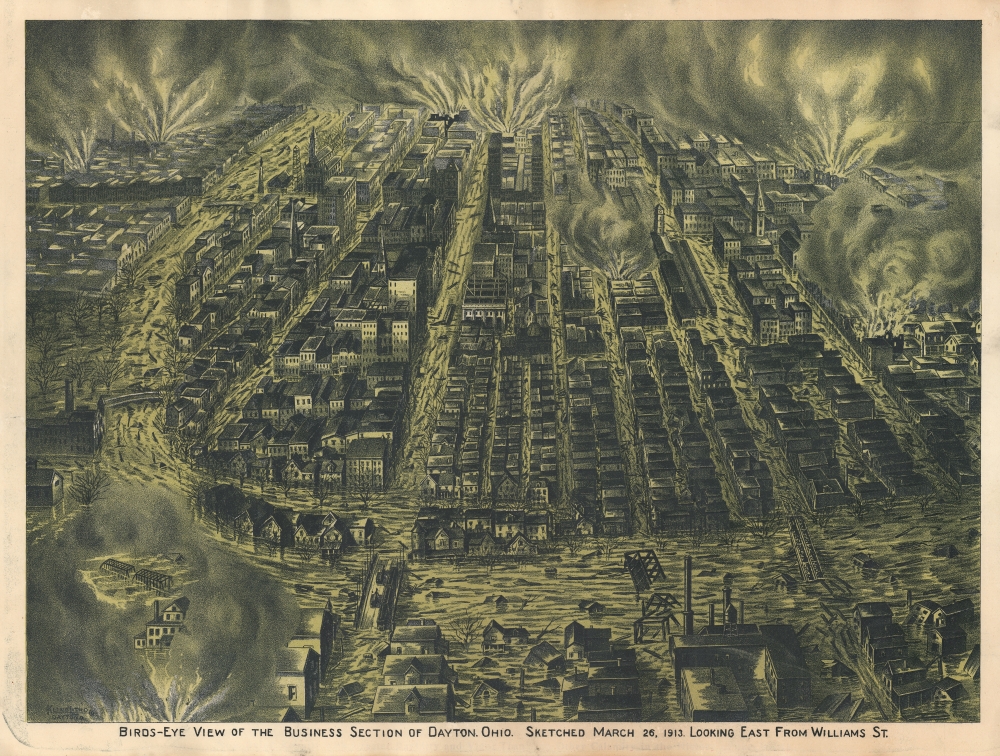Digital Image: 1913 Chromolithograph View of the Dayton, Ohio Flood and Fire
DaytonFlood-ring-1913_d
Title
1913 (dated) 20.5 x 27.25 in (52.07 x 69.215 cm)
Description
FOR THE ORIGINAL ANTIQUE MAP, WITH HISTORICAL ANALYSIS, CLICK HERE.
Digital Map Information
Geographicus maintains an archive of high-resolution rare map scans. We scan our maps at 300 DPI or higher, with newer images being 600 DPI, (either TIFF or JPEG, depending on when the scan was done) which is most cases in suitable for enlargement and printing.
Delivery
Once you purchase our digital scan service, you will receive a download link via email - usually within seconds. Digital orders are delivered as ZIP files, an industry standard file compression protocol that any computer should be able to unpack. Some of our files are very large, and can take some time to download. Most files are saved into your computer's 'Downloads' folder. All delivery is electronic. No physical product is shipped.
Credit and Scope of Use
You can use your digial image any way you want! Our digital images are unrestricted by copyright and can be used, modified, and published freely. The textual description that accompanies the original antique map is not included in the sale of digital images and remains protected by copyright. That said, we put significant care and effort into scanning and editing these maps, and we’d appreciate a credit when possible. Should you wish to credit us, please use the following credit line:
Courtesy of Geographicus Rare Antique Maps (http://www.geographicus.com).
How Large Can I Print?
In general, at 300 DPI, you should at least be able to double the size of the actual image, more so with our 600 DPI images. So, if the original was 10 x 12 inches, you can print at 20 x 24 inches, without quality loss. If your display requirements can accommodate some loss in image quality, you can make it even larger. That being said, no quality of scan will allow you to blow up at 10 x 12 inch map to wall size without significant quality loss. For more information, it is best consult a printer or reprographics specialist.
Refunds
If the high resolution image you ordered is unavailable, we will fully refund your purchase. Otherwise, digital images scans are a service, not a tangible product, and cannot be returned or refunded once the download link is used.
Cartographer S
George Ring (July 4, 1865 - November 23, 1932) was a German-American artist active in Dayton, Ohio, in the early 20th century. Ring was born in either Rybńik, Poland, or Berlin, Germany (This part of Poland was, at the time, under German control and was undergoing active Germanization.). He emigrated to the United States in 1870, settling in Ohio. He was naturalized in 1886. In 1892, Ring married Ohio native Sarah Morgenroth (1868 - 1944). Little is known of his education, but as early as 1900, he was listed in census documents as a lithographic artist in Coshocton, Ohio. He appears in Dayton city directories as an artist or a lithographer as early as 1912. This would have been a fateful time to move to Dayton, as in 1913, the city was destroyed by a disastrous flood, which Ring faithfully recorded in a dramatic view. Ring remained in Dayton directories until about 1921, after which he relocated to Cincinnati. Around his time, he began to develop health problems, leading to a long decline until his death in 1932. More by this mapmaker...
Kling Lithographing (1907 - 1916) was an American lithography firm based in Dayton, Ohio, founded by first-generation German-American brothers Aloys William Kling (July 3, 1870 - February 6, 1950) and George John Kling (June 16, 1874 - February 8, 1918). Another brother, Louis J. Kling, later joined the firm. The elder brother, Aloys, was born in Cincinnati but moved to Dayton in 1891. He invented a specialized print roller, which he patented in 1903. He appears to have been employed as a foreman with a Dayton lithographing firm, but it is unclear which one. Kling Lithographing was incorporated in 1907 with a capitalization of about 15,000 USD. It was active for about 10 years, but we not only had 2-3 copyright entries associated with the business. Likely, they mainly focused on local job work. The firm went into receivership in 1916, at which time its assets were sold at public auction. George died two years later. Aloys went on to be associated with Strowbridge Lithography. Learn More...

